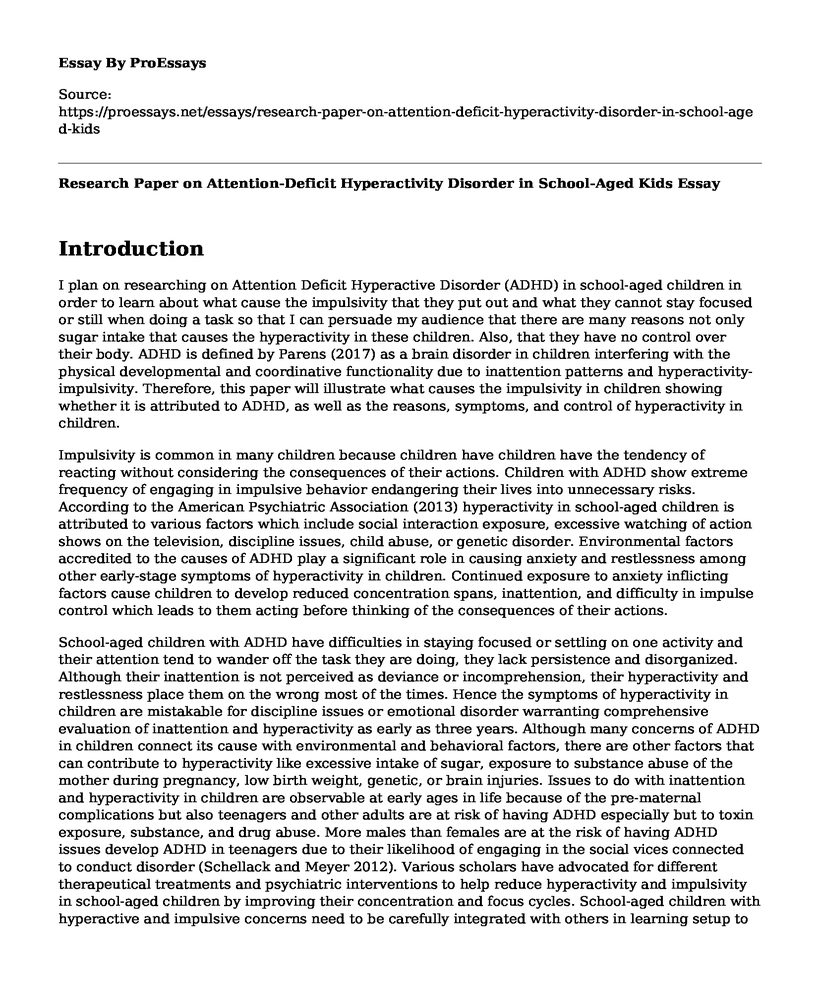Introduction
I plan on researching on Attention Deficit Hyperactive Disorder (ADHD) in school-aged children in order to learn about what cause the impulsivity that they put out and what they cannot stay focused or still when doing a task so that I can persuade my audience that there are many reasons not only sugar intake that causes the hyperactivity in these children. Also, that they have no control over their body. ADHD is defined by Parens (2017) as a brain disorder in children interfering with the physical developmental and coordinative functionality due to inattention patterns and hyperactivity-impulsivity. Therefore, this paper will illustrate what causes the impulsivity in children showing whether it is attributed to ADHD, as well as the reasons, symptoms, and control of hyperactivity in children.
Impulsivity is common in many children because children have children have the tendency of reacting without considering the consequences of their actions. Children with ADHD show extreme frequency of engaging in impulsive behavior endangering their lives into unnecessary risks. According to the American Psychiatric Association (2013) hyperactivity in school-aged children is attributed to various factors which include social interaction exposure, excessive watching of action shows on the television, discipline issues, child abuse, or genetic disorder. Environmental factors accredited to the causes of ADHD play a significant role in causing anxiety and restlessness among other early-stage symptoms of hyperactivity in children. Continued exposure to anxiety inflicting factors cause children to develop reduced concentration spans, inattention, and difficulty in impulse control which leads to them acting before thinking of the consequences of their actions.
School-aged children with ADHD have difficulties in staying focused or settling on one activity and their attention tend to wander off the task they are doing, they lack persistence and disorganized. Although their inattention is not perceived as deviance or incomprehension, their hyperactivity and restlessness place them on the wrong most of the times. Hence the symptoms of hyperactivity in children are mistakable for discipline issues or emotional disorder warranting comprehensive evaluation of inattention and hyperactivity as early as three years. Although many concerns of ADHD in children connect its cause with environmental and behavioral factors, there are other factors that can contribute to hyperactivity like excessive intake of sugar, exposure to substance abuse of the mother during pregnancy, low birth weight, genetic, or brain injuries. Issues to do with inattention and hyperactivity in children are observable at early ages in life because of the pre-maternal complications but also teenagers and other adults are at risk of having ADHD especially but to toxin exposure, substance, and drug abuse. More males than females are at the risk of having ADHD issues develop ADHD in teenagers due to their likelihood of engaging in the social vices connected to conduct disorder (Schellack and Meyer 2012). Various scholars have advocated for different therapeutical treatments and psychiatric interventions to help reduce hyperactivity and impulsivity in school-aged children by improving their concentration and focus cycles. School-aged children with hyperactive and impulsive concerns need to be carefully integrated with others in learning setup to help them learn interaction skills. However, the different stimulants used for intervention measures fail to work because of children with ADHD lack control of their bodies.
Conclusion
In conclusion, understanding the causes, symptoms, and intervention of school-aged children with Attention Deficit Hyperactive Disorder goes a long way in making a correct evaluation to distinguish ADHD from behavioral or emotional concerns in children. Establishing the various causes of ADHD will help educators to help schools aged children with hyperactive and impulsivity fit in the learning set-up without much interruption of others in the classroom.
Works Cited
ADHD in Children and Adults: Diagnosis... (PDF Download Available). Available from: https://www.researchgate.net/publication/51057686_ADHD_in_Children_and_Adults_Diagnosis_and_Prognosis [accessed May 22 2018].
American Psychiatric Association, Diagnostic and Statistical Manual of Mental Disorders.5th ed. Washington, DC: American Psychiatric Association, 2013.
Parens E, Johnston J. Facts, values, and attention-deficit hyperactivity disorder (ADHD): an update on the controversies. Child-Adolescent Psychiatry Mental Health, 2017, 3:1
Schellack, N. and Meyer, H.C. The management of attention deficit hyperactivity disorder in children. South African Pharmaceutical Journal 2012;79(10):12-20.
Cite this page
Research Paper on Attention-Deficit Hyperactivity Disorder in School-Aged Kids. (2022, Jun 05). Retrieved from https://proessays.net/essays/research-paper-on-attention-deficit-hyperactivity-disorder-in-school-aged-kids
If you are the original author of this essay and no longer wish to have it published on the ProEssays website, please click below to request its removal:
- The Fatal Surfing Incident
- Summary of the Findings on Intercultural Competence of Teachers
- Concept of Sociology of Emotions Case Study
- Should Children Carry Cellphones in School? Essay
- Essay Sample on Body Image
- Evaluation of the Severity of Depression and Anxiety Paper Example
- Reflective Teaching: Critical Thinking for Improved Outcomes - Essay Sample







